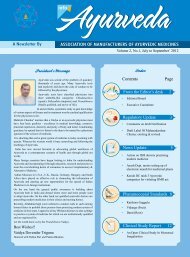Issue 12 - amam-ayurveda.org
Issue 12 - amam-ayurveda.org
Issue 12 - amam-ayurveda.org
Create successful ePaper yourself
Turn your PDF publications into a flip-book with our unique Google optimized e-Paper software.
cells, discontinuous ring consisting of 2-3 rows of stone cells and group<br />
of phloem fibres, stone cells variable in shape with simple pits, vascular<br />
strands as radiating strips usually 8-<strong>12</strong> of xylem and phloem some reaching<br />
up to the centre, phloem consists of small strands of sieve elements and<br />
parenchyma just below the ring of stone cells, xylem consists of vessels,<br />
tracheids, fibres and xylem parenchyma, vessels and tracheids show simple<br />
pits on the walls, xylem parenchyma usually thick-walled and lignified<br />
but due to delignification patches of thin-walled parenchyma appear in<br />
the xylem region., medullary rays 1-3 seriate appear to be very wide at<br />
a number of places due to addition of delignified xylem parenchymatous<br />
cells, ray cells thin-walled, a few lignified and thick-walled while some<br />
show reticulate thickening, plenty of starch grains present in some of ray<br />
cells.<br />
Powder – Greyish-brown; under microscope shows group of cells, fibres<br />
and starch grains; crystals absent.<br />
IDENTITY, PURITY AND STRENGTH<br />
Foreign matter: Not more than 2 per cent,<br />
Total Ash: Not more than 7 per cent,<br />
Acid-insoluble ash: Not more than 1 per cent,<br />
Alcohol-soluble extractive: Not less than 11 per cent,<br />
Water-soluble extractive: Not less than 13 per cent,<br />
CONSTITUENTS - Alkaloids, saponin and quarternary ammonium<br />
bases, flavonol and sterol.<br />
PROPERTIES AND ACTION<br />
Rasa : Tikta, Katu<br />
Guna : Laghu, Tikshna<br />
Virya : Ushna<br />
Vipaka : Katu<br />
Karma : Tridoshashamana, Raktashodhaka, Vishaghna, Bhagnasand-<br />
hanakrit, Grahi, Stanyashodhana<br />
IMPORTANT FORMULATIONS - Pushyanuga Churna, Pradarantaka<br />
Lauha, Sarasvata Ghrita, Brihat Gangadhara Churna, Stanyashodhana<br />
Kashaya Churna<br />
THERAPEUTIC USES - Shularoga, Atisara, Kushtha, Kandu, Jvara,<br />
Chardi, Stanyadushti<br />
DOSE - 3-6 g of the drug in powder form.<br />
JAMBU (Seed)<br />
(API Part –I, Vol. II, Pg.54)<br />
Jambu consists of dried seeds of Syzygium cuminii (Linn.) Skeels Syn.<br />
Eugenia jambolana Lam.; E. cuminii Druce. (Fam. Myrtaceae); a large<br />
info Ayurveda, Volume 1, No.<strong>12</strong>, April-June’ 20<strong>12</strong><br />
evergreen tree, attaining a height of 30 m and a girth of 3.6 m with a bole<br />
up to 15 m, found throughout India upto an altitude of 1,800 m.<br />
SYNONYMS<br />
Bengali : Badjam, Kalajam<br />
English : Jambul tree<br />
Gujrati : Gambu, Jamun<br />
Hindi : Jamuna<br />
Kannada : Nerale Beeja, Jambu Nerale<br />
Malayalam : Njaval<br />
Marathi : Jambul<br />
Oriya : Jam Kol, Jamu Kol<br />
Punjabi : Jaamun<br />
Tamil : Naval<br />
Telugu : Alla Nereduchettu, Neredu chettu<br />
Urdu : Jamun<br />
DESCRIPTION<br />
a) Macroscopic:<br />
2-5 seeds, compressed together into a mass resembling a single seed,<br />
the whole seed enclosed in a cream coloured, coriaceous covering,<br />
smooth, oval or roundish, 1 cm long, 1 cm wide, brownish-black; taste,<br />
astringent.<br />
b) Microscopic<br />
Seed - Shows cotyledons consisting of single layered epidermis, mesophyll<br />
composed of isodiametric, thin-walled, parenchymatous cells fully packed<br />
with simple starch grains, oval, rounded measuring 7-28 μ in dia., a few<br />
schizogenous cavities are also found.<br />
Powder - Brown coloured; shows a few parenchymatous cells and<br />
numerous oval, rounded starch grains, measuring 7-28 μ in diameter.<br />
IDENTITY, PURITY AND STRENGTH<br />
Foreign matter: Not more than 1 per cent,<br />
Total Ash: Not more than 5 per cent,<br />
Acid-insoluble ash: Not more than 1 per cent,<br />
Alcohol-soluble extractive: Not less than 6 per cent,<br />
Water-soluble extractive: Not less than 15 per cent.<br />
T.L.C.<br />
T.L.C. of alcoholic extract of the drug on Silica gel ‘G’ plate using<br />
Toluene:Ethylaceate<br />
(90: 10) shows under U.V. light (366 nm) one fluorescent zone at Rf.<br />
0.30 (blue). On exposure to Iodine vapour four spots appear at Rf. 0.<strong>12</strong>,<br />
0.20, 0.30 and 0.95 (all yellow). On spraying with Vanillin-Sulphuric acid<br />
reagent and heating the plate for ten minutes at 105°C, three spots appear<br />
at Rf. 0.20, 0.30 and 0.95 and 0.95 (all violet).<br />
CONSTITUENTS<br />
Glycoside (Jamboline), Tannin, Ellagic acid and Gallic acid.<br />
PROPERTIES AND ACTION<br />
Rasa : Madhura, Amla, Kashaya<br />
Guna : Guru, Ruksha<br />
Virya : Shita<br />
Vipaka : Katu<br />
Karma : Vatala, Pittahara, Kaphahara, Vishtambhi, Grahi<br />
IMPORTANT FORMULATIONS – Pushyanuga Churan<br />
THERAPEUTIC USES - Madhumeha, Udakameha<br />
DOSE - 3-6 g of the drug in powder form.<br />
6


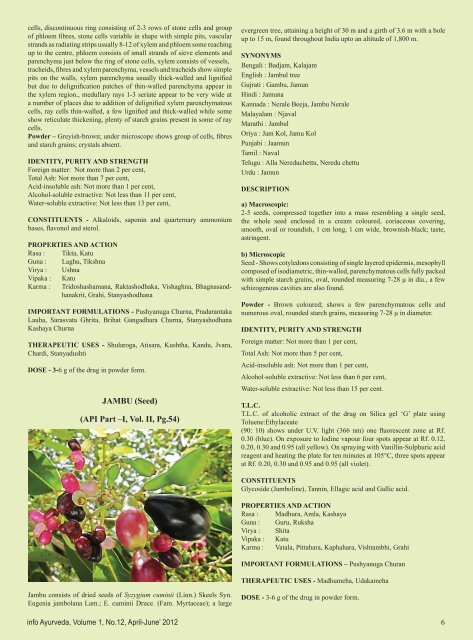

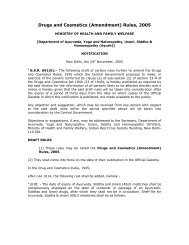
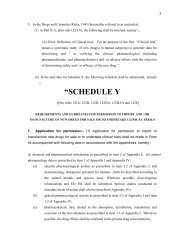
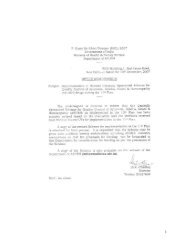

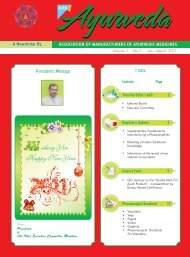

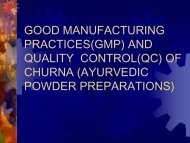
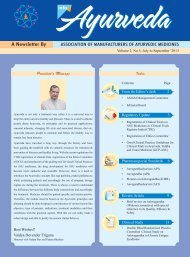
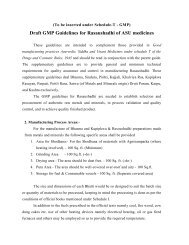
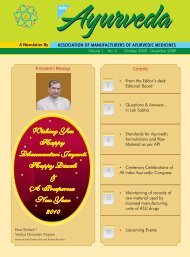
![[To be published in Gazette of India Part II Section 3, sub-section iii]](https://img.yumpu.com/28570283/1/190x245/to-be-published-in-gazette-of-india-part-ii-section-3-sub-section-iii.jpg?quality=85)

